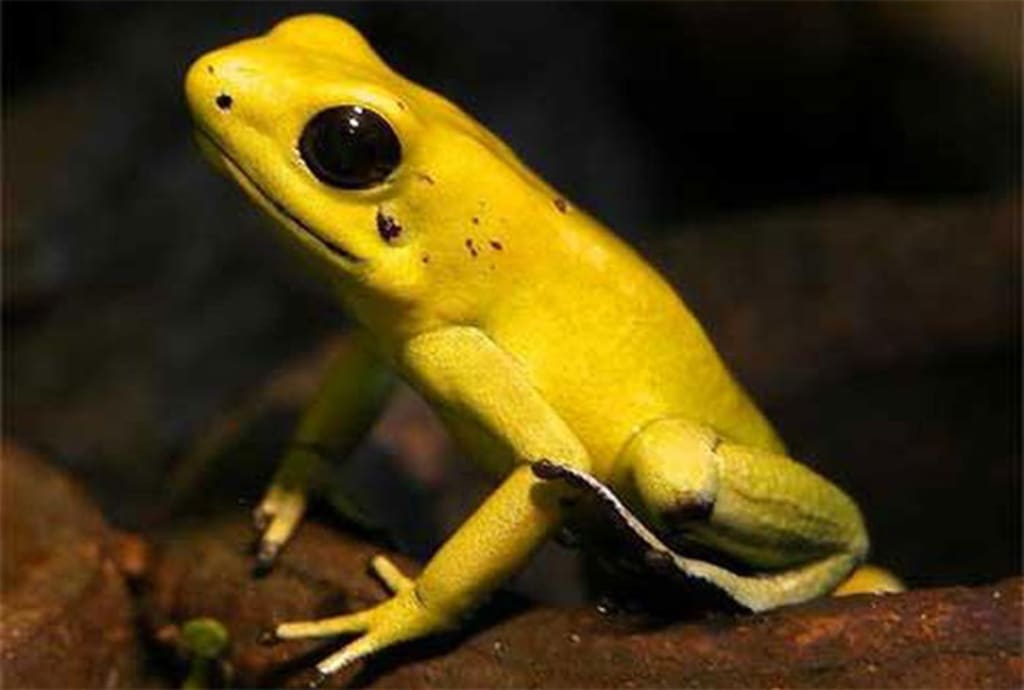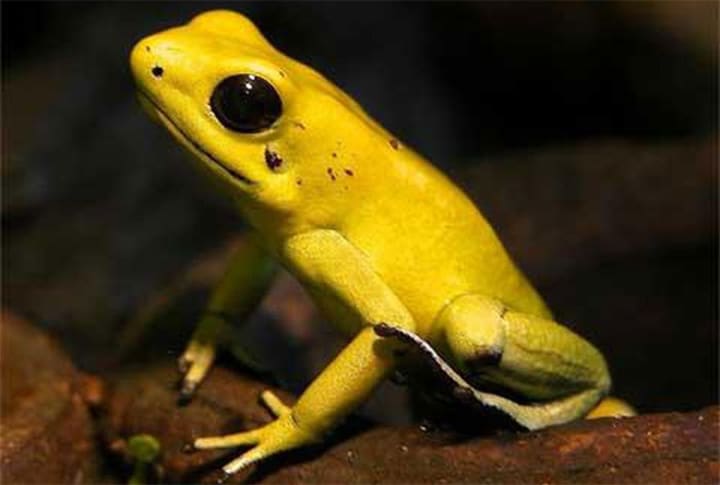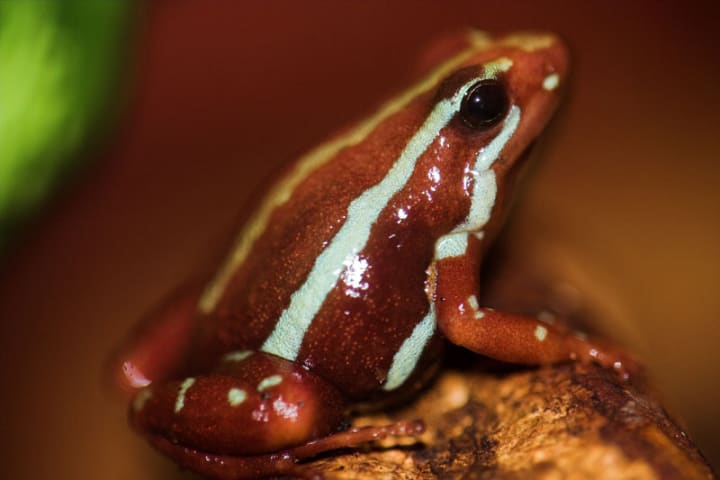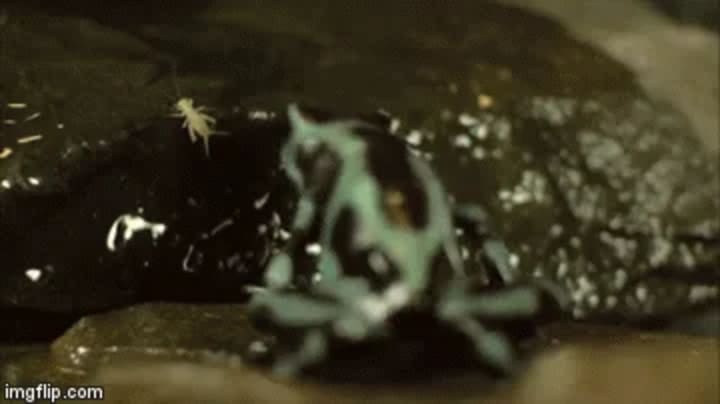Beware of beautiful frogs that contain deadly poison
Known as the most “venomous” creature in the world, the poison of the golden dart frog paralyzes the nervous system, causing muscle paralysis and leading to death. The venom of a single golden dart frog can kill nearly 20 healthy men or even 2 African bull elephants.

Known as the most “venomous” creature in the world, the poison of the golden dart frog paralyzes the nervous system, causing muscle paralysis and leading to death. The venom of a single golden dart frog can kill nearly 20 healthy men or even 2 African bull elephants.
Venom is not only a natural weapon but also used to attack and neutralize prey in the animal world. Surpassing countless "heavyweight" opponents, this small creature is the creature that possesses the most terrifying venom in the world: the creature that can kill people the fastest!
That is the poison dart frog (scientific name: Dendrobatidae) is a group of frog species in the family Dendrobatidae that live in Central and South America.
They are so named because their venom was used by Native Americans to coat their hunting darts.
The most poisonous animal on the planet is the golden poison frog (Phyllobates terribilis) of Colombia. Its venom can kill 10-20 men, or 2 African elephants. In particular, the skin of some species of this frog group contains a poison 200 times stronger than morphine.

Golden dart frog.
Their skin secretes batrachotoxin , a neurotoxin that paralyzes the nervous system, causing muscle paralysis and death. The venom of a single golden dart frog can kill nearly 20 healthy men or even two African bull elephants.
This frog has a very colorful and eye-catching appearance. However, don't let that "eye-catching" appearance fool you because just a small touch to their skin can quickly stop a person's heart.
Compared to other poison dart frogs such as the black poison dart frog or the bicolor poison dart frog, the Kokoe poison dart frog (Phyllobates aurotaenia) is many times more toxic. What's more frightening is that their venom can last up to 1 year !
If you accidentally touch them, it does not mean that you can be poisoned through the skin, because they only excrete toxins through the skin when they feel threatened, but that does not mean you can touch them comfortably.
Although the tiny frog has venom that can kill an elephant, its ancestors, which lived 40 to 45 million years ago, were not poisonous at all. They were able to secrete venom because they ate poisonous creatures. This tiny frog often eats a type of ant that contains toxic alkaloid molecules, and they do not waste any part of this meal. After eating, the poison dart frog stores the toxic molecules in its glands and synthesizes its own poison.
Slightly smaller than the golden poison dart frog, the black-legged poison dart frog or bicolor poison dart frog (Phyllobates bicolor) of western Colombia kills humans with just 150 micrograms of toxin. Victims will experience fever, pain, convulsions, respiratory and muscular paralysis, and death.
The Kokoe poison dart frog (Phyllobates aurotaenia) is the smallest of the poison dart frogs. Its venom can penetrate wounds and pores, causing pain, fever, convulsions, and paralysis. Indigenous people in Colombia often use its venom to coat hunting arrows.
The Tri-Colored Poison Frog (Epipedobates tricolor) is less than half an inch long, but its venom can easily kill predators and humans. The frog is now endangered in Ecuador because it is being exploited for the painkiller epibatadine, which is 200 times more potent than morphine.

Tricolor Poison Frog.
Next, there is the black-spotted tree frog (Ranitomeya variabilis) that lives in the rainforests of Ecuador and Peru, and whose skin venom can kill five people.
The yellow-banded dart frog (Phyllobates vittatus) is one of the four most poisonous dart frogs. But it is less toxic, and can cause pain, mild convulsions, and even paralysis in some cases.
The striped poison dart frog (Phyllobates lugubris) of Central America has a relatively low toxin level of 0-0.8 micrograms but is still capable of causing heart failure in its predators.
Although not as deadly as other poison dart frogs, the humpback poison dart frog (Dendrobates Azureus) is still a dangerously poisonous frog.

Humpbacked dart frog.
Still part of the famous poison dart frog genus, the red poison dart frog (Oophaga pumilio) can cause swelling and burns to those who are poisoned.
The red-black poison frog (Ranitomeya reticulatus) found in Peru is moderately toxic but can kill animals such as chickens and injure humans.
The third largest poison dart frog at about 2 inches long, the dyed poison frog (Dendrobates tinctorius) comes in a variety of colors and contains poison for defense. It was used by tribes to coat hunting arrows.
Finally, the giant leaf frog (Phyllomedusa bicolor) , also known as the monkey frog, has a mild toxin that causes pain, upset stomach, and hallucinations when ingested. It is now endangered because some of its toxic components can be used in the treatment of AIDS and cancer.
Despite their extremely poisonous nature, some people still keep poison dart frogs as pets. Because their poison comes from what they eat, owners can also “neutralize” a poison dart frog by feeding it a strict diet that includes non-poisonous insects.
Additionally, it is safe to handle a poison dart frog if it only eats bugs like fruit flies and crickets.
On the other hand, if they live in Hawaii or British Columbia, Canada, it is illegal to keep poison dart frogs. Accordingly, this law is enforced to protect poison dart frogs, but also to protect humans.
Nowadays, due to deforestation, especially tropical forests, poison dart frogs are in danger of extinction. Their habitat is also shrinking.
Unique hunting method of poison dart frog

Poison dart frogs have a very unique way of hunting.
Food is the secret behind the poison dart frog’s powerful venom. Surprisingly, however, poison dart frogs don’t use their venom to hunt. Instead, they lure their prey to them by tapping their long, slender middle toes on the ground.
Scientists believe that these tapping rhythms mimic the sound of rain to lure hidden insects out. When they come out, they fall into the frog's mouth.
Poison dart frogs shoot out their long, sticky tongues and swallow their prey whole. This is also the secret to their extremely potent poison.
Why are poison dart frogs not poisoned?
Poison dart frogs and other poisonous animals have three tricks to prevent self-poisoning, according to researcher Fayal Abderemane-Ali at the Cardiovascular Research Institute of the University of California (USA).
The most common trick that helps venomous animals survive poisoning involves a genetic mutation that slightly changes the shape of the toxin's target protein so that the toxin cannot bind to the protein.
For example, the poison frog Dendrobates tinctorius azureus carries a toxin called epibatidine , which is not addictive but is very potent. According to a 2017 study published in the journal Science, these poison frogs have evolved adaptations in their acetylcholine receptors that slightly alter the shape of those receptors, thereby making them resistant to the toxin.
The second trick that poisonous predators often use is the ability to completely eliminate the poison from their bodies. This is just another way for animals to avoid being poisoned by the things they eat.
The third technique is called sequestration. In this method, animals develop systems to store toxins in their bodies without causing any problems or effects to themselves.
About the Creator
HK Decor
Telling stories my heart needs to tell <3 life is a journey, not a competition
If you like what you read, feel free to leave a tip,I would love some feedback
https://s.shopee.vn/7fFUMxnnBx?share_channel_code=8
Enjoyed the story? Support the Creator.
Subscribe for free to receive all their stories in your feed.






Comments
There are no comments for this story
Be the first to respond and start the conversation.